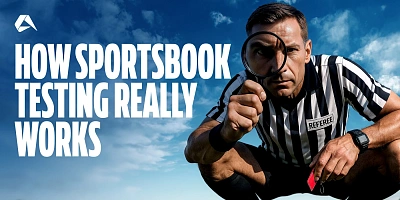Many bettors, and even some operators in the early stages of development, are uncertain of how betting odds really work, let alone how they are compiled. This is more than just a minor issue. It is something that can lead to missed opportunities and profit imbalances. As an operator, without knowledge and mastery of betting odds, there’s a real risk of setting odds that fail to attract balanced action, leaving margins exposed and vulnerable.
Think about it this way. Betting odds aren’t just numbers. They represent probabilities, and the sharper your understanding of them is, the better positioned you are to maximise your returns while managing risk. Statistics show that operators who actively adjust and fine-tune their odds based on real-time insights see a significant improvement in profitability. Those who don’t are often left scrambling when unpredictable shifts in the market occur.
Thus, when you truly understand the odds, you gain the power to secure a profitable sportsbook that keeps bettors engaged and coming back for more. Curious about how to get there? Keep reading as we dive deeper into the knowledge that could be the key to your long-term profitability and success.
The Role of Betting Odds and How They Work
Set by sportsbooks based on analytical data, betting odds represent the likelihood of a specific outcome occurring in a sporting event. They serve two essential functions: reflecting the probability of an event and determining the payout for successful wagers. Essentially, betting odds quantify the risk for bettors, showing how much they stand to win based on their stake and the perceived difficulty of the outcome.
In simpler terms, higher odds indicate lower probabilities but greater potential returns, while lower odds signal higher probabilities with smaller payouts. For operators, odds are more than just numbers. They are strategic tools for balancing risk, attracting bettors, and managing profitability. Betting odds provide insight into market sentiment and help operators fine-tune their offerings to maintain a competitive edge in the fast-moving world of sports betting.
Formats for Betting Odds
Betting odds come in various formats, offering operators and bettors unique ways to assess potential returns and risks depending on the region and betting market. Here is an explanation of the main variations:
American Odds
American odds are widely used in the following regions:
| COUNTRY | COMMON USE |
|---|---|
| United States | Standard format |
| Canada | Commonly used in sports betting, though decimal odds are also used. |
| Mexico | Standard format |
| Philippines | Due to the influence of American sports. |
| Colombia | Favoured in many regions |
| Venezuela | Mostly used, especially in major sports |
| Puerto Rico | Standard format |
| Dominican Republic | Standard format |
| Japan | Occasionally used, particularly for international sports |
American odds, also known as moneyline odds, developed alongside the rise of organised sports betting in the United States around the late 19th to early 20th century. To this day, this odds format remains popular across North American betting markets such as American football, basketball and baseball. American odds are presented in positive or negative numbers, indicating teams and individuals as underdogs and favourites, respectively. Positive odds, such as +150, show how much profit you’d make from a £100 bet on an underdog. Conversely, negative odds, like -110, represent how much you’d need to wager to win £100 when betting on the favourite.
American odds are widely favoured for their simplicity and straightforward calculations, making it easy for bettors to assess risk and reward quickly. Reading them is intuitive. Underdogs offer larger payouts, while favourites offer smaller, safer returns. This system supports strategic decision-making for both operators and sports bettors.
How to Calculate Payouts for American Odds
American odds are positive or negative, depending on which team is expected to win.
Positive odds: Represent the profit you make on a £100 bet.
Negative odds: Indicate how much you need to wager to win £100.
Example 1: Positive Odds (+150)
If the odds are +150, it means that for every $100 you bet, you stand to win $150 in profit. The formula is: Profit = (Stake x Odds) / 100
For a $50 bet at + 150, the profit is:
(50 x 150) / 100 = $75 profit
So, the total return is $75 profit + $50 stake = $125.
Example 2: Negative Odds (-120)
When betting on favourites, such as at -120, the odds show how much you need to wager to make a $100 profit. The formula is:
Profit = (Stake / Odds) x 100
For a $60 bet at -120, the profit is:
(60 / 120) x 100 = $50 profit
Total return = $50 profit + $60 stake = $110.
Example 3: Custom Stake and Positive Odds (+200)
For a higher positive (favourable) odds bet like +200 with a stake of $40, the formula remains: Profit = (Stake x Odds) / 100
(40 x 200) / 100 = $80 profit
Total return = $80 profit + $40 stake = $120.
Decimal Odds
Decimal Odds are commonly used in:
| COUNTRY | COMMON USE |
|---|---|
| Europe | Germany, Italy, Spain, France, Norway Netherlands, Portugal, Denmark, Sweden, Finland |
| Australia | Standard format |
| New Zealand | Standard format |
| South Africa | Most common. Fractional format is also used. |
| Canada | Widely used, though American odds are common for sports betting |
| Singapore | Widely used alongside Malaysian odds format |
Decimal odds are displayed as figures like 2.50 or 1.80, which is the preferred format widely used in Europe, Australia, and New Zealand due to the clarity it offers sports bettors. Originating in European betting markets, they show the total return, including the stake, which makes it easy for bettors to understand how much they will receive per wager.
The calculation is straightforward. Simply multiply the stake by the decimal odds to get the total payout, covering both the original stake and the profit. This format is favoured because it provides a clear snapshot of potential returns, helping operators and bettors make informed decisions quickly.
How to Calculate Payouts for Decimal Odds
Decimal odds represent the total return, including both the profit and the stake, displayed as a single number (e.g., 2.50), which you multiply by your stake to calculate the total return.
The formula is: Total Return = Stake x Decimal Odds.
Example 1: Simple Bet (2.50 Odds)
For a €100 bet at odds of 2.50, the total return is calculated as:
Total Return = 100 x 2.50 = €250
In this case, you earn €150 in profit (total return minus your original stake).
Example 2: Lower Odds (1.80 Odds)
A €50 wager at odds of 1.80 would be calculated as:
Total Return = 50 x 1.80 = €90
Here, the profit is €40 (total return minus stake).
Example 3: Higher Odds (3.75 Odds)
With a €40 bet at odds of 3.75, the total return is:
Total Return = 40 x 3.75 = €150
The profit in this case would be €110.
Fractional Odds
Fractional odds are commonly used in:
| COUNTRY | COMMON USE |
|---|---|
| United Kingdom | Standard format |
| Ireland | Standard format |
| India | Popular in some betting markets, especially cricket and other major sports |
| South Africa | Commonly used alongside decimal odds in various sports |
| United Arab Emirates (UAE) | Often preferred in some betting markets, especially niche sports |
Fractional odds are historically rooted in British betting culture and traditions, most commonly used in the UK, Ireland, and South Africa. The fractional odds format has become synonymous with horse racing over the years, but it is also applied to other traditional British sports like football, rugby, and cricket. In essence, they represent the ratio of profit relative to the stake. For example, odds of 5/1 indicate that a bettor will win £5 for every £1 wagered, in addition to receiving their original stake back if the wager is successful.
Their appeal lies in the straightforward way they showcase potential profits, typical at a glance in many instances without making complex calculations. This makes this format a favoured option in regions with a rich betting culture. While they may require some familiarity to interpret, their simplicity has kept them at the forefront in many betting markets.
How to Calculate Payouts for Fractional Odds
Fractional odds represent your profit on a bet relative to your stake. For example, fractional odds of 8/1 mean you will win £8 for every £1 wagered, in addition to receiving your original stake.
Formula: Profit = (Stake x Fractional Odds)
Total Return = Profit + Stake
Example 1: Simple Bet (5/1 Odds)
For a £10 bet at odds of 5/1, the calculation is as follows:
Profit = 10 x 5 = £50
Total Return = £50 (profit) + £10 (stake) = £60
Example 2: Shorter Odds (2/5)
A £20 bet at odds of 2/5 would result in:
Profit = 20 x (2/5) = £8
Total Return = £8 (profit) + £20 (stake) = £28
Example 3: Larger Bet (10/3)
For a £30 bet at odds of 10/3, the payout is:
Profit = £30 x (10/3) = £100
Total Return = £100 (profit) + £30 (stake) = £130
Other Odds Formats
Other odds formats used include:
| COUNTRY | COMMON USE |
|---|---|
| Malaysia | Malaysian odds are widely used |
| Hong Kong | Hong Kong odds are widely used |
| Indonesia | Indonesian odds are widely used |
| Thailand | Thai betting markets often feature formats similar to those used in Malaysia and Hong Kong, reflecting local preferences |
| Vietnam | Regional variations of odds |
Less common betting odds formats, such as Malaysian, Hong Kong and Indonesian odds, also exist outside of the three commonly preferred formats of American, decimal and fractional odds. These formats have a strong regional significance and reflect local betting customs. Malaysian odds, for example, are primarily used in south-east Asia and display positive or negative values similar to American odds. Indonesian odds offer another variation of American odds with differing scales, allowing bettors to understand risk and reward easily.
Hong Kong odds, on the other hand, resemble fractional odds but without fractions, making them easier for local bettors to interpret while still clearly showing profit ratios. In Thailand and Vietnam, betting formats adapt to local preferences, often integrating regional variations of the leading odds systems. These formats suit the local markets, reflecting the unique blend of global influences and regional traditions in betting. Their specialised use supports betting environments that resonate with local culture.
How to Calculate Payouts for Other Formats
In certain regions, traditional betting formats like American, decimal, and fractional odds have evolved into regional variations tailored to local markets. While these formats remain rooted in global betting systems, countries such as Malaysia, Hong Kong, Indonesia, Thailand, and Vietnam have developed unique odds systems that closely align with, but differ slightly from, the established formats.
Malaysia – Closest to American Odds
The Malaysian odds format follows a format similar to American odds, with both positive and negative values. However, they are expressed on a smaller scale. Positive odds indicate how much profit you will make on a bet, while negative odds show how much you need to stake to win a certain amount.
Formula for positive Malaysian odds: Profit = Stake x Odds
For instance, a $100 bet at +0.50 yields a profit of:
$100 x 0.50 = $50
Total return = $100 stake + $50 profit = $150.
Negative Malaysian odds (e.g., -0.50) function similarly to American odds, but here, betting $50 would yield $100 in profit.
Hong Kong – Closest to Fractional Odds
Hong Kong odds resemble fractional odds but without the use of fractions, making them easier to calculate. These odds represent the profit relative to the stake.
Formula: Profit = Stake x Odds
A £100 bet at 0.75 odds returns a profit of:
£100 x 0.75 = £75
Total return = £100 stake + £75 profit = £175.
Indonesia – Closest to American Odds
Indonesian odds follow the American odds structure but are expressed in a different range. Positive Indonesian odds indicate the potential profit relative to the stake, while negative Indonesian odds work much like negative American odds, showing how much you need to bet to win a specified amount.
Formula for positive odds: Profit = Stake x Odds
For a $50 bet at +1.50, the profit is:
$50 x 1.50 = $75
Total return = $50 stake + $75 profit = $125.
Thailand – Closest to Decimal Odds
Thailand typically uses decimal odds. Formula:
Total Return = Stake x Decimal Odds
For example, a £100 bet at 2.50 odds results in a total return of:
£100 x 2.50 = £250
This includes the £100 stake and £150 profit.
Vietnam – Closest to Decimal Odds
Vietnam also typically follows the decimal odds format, and the total return is calculated similarly to European decimal odds. Formula:
Total Return = Stake x Odds
A £50 bet at 3.00 odds yields:
£50 x 3.00 = £150
This figure includes both the original stake and profit.
Betting odds formulas at a glance
| ODDS FORMAT | PRESENTED AS | PROFIT FORMULA |
|---|---|---|
| American Odds | +150 -120 | (P) Profit = Stake x (Odds / 100) (N) Profit = (Stake / -Odds) x 100 |
| Decimal Odds | 2.50, 1.80, 3.75 | Profit = Stake x (Odds - 1) |
| Fractional Odds | 5/1. 10/1, 1/3 | Profit = Stake x (Numerator / Denominator) |
| Malaysian Odds | +0.50 -0.50 | (P) Profit = Stake x Odds (N) Profit = (Stake / -Odds) |
| Hong Kong Odds | 0.75 | Profit = Stake x Odds |
| Indonesian Odds | +1.50 - 2.00 | (P) Profit = Stake x Odds (N) Profit = (Stake / -Odds) |
Betting Odds Calculators
To simplify complex calculations, sports bettors and operators can use betting odds calculators to save time and improve decision-making. They allow users to input odds in various formats, such as American, decimal or fractional, and instantly calculate potential profits and returns. Features often include the ability to handle multiple bet types like parlays, singles, and double bets. In practice, they streamline calculations, offering clarity and accuracy on potential payouts.
Here are the top three most widely used betting odds calculators available for public use:
Odds Shark Betting Odds Calculator
This calculator helps bettors calculate potential winnings for American, decimal and fractional odds, making it easy to understand returns before placing a bet.
The Odds Calculator
A versatile tool for single, parlay and system bets, allowing users to calculate returns based on various betting types and formats. The odds calculator also provides an odds converter that converts odds from one format to another.
Betmentor Odds Calculator
The Betmentor odds calculator supports over 20 bet types, including bigger accumulator bets like each way, Yankees, Heinz and Goliaths, providing accurate payout estimates for fractional and decimal odds.
Understanding Implied Probability
In sports betting, betting odds are built around the concept of probability, meaning the probability of a specific outcome occurring. Implied probability is the process of converting betting odds into a percentage that shows the probability of an event happening.
For bookmakers and sports betting operators, this conversion is essential for assessing the value of a bet. It is also a fundamental calculation used for risk management, guiding odds makers in efforts to align odds with actual probabilities to balance their books accurately and effectively. Such insight enables them to make more informed and profitable decisions.
How to convert betting odds into implied probability
Calculating the Implied Probability of American Odds
Positive odds: Implied Probability = 100 / (Odds + 100).
Example: For +200, 100 / (200 + 100) = 33.3%.
Negative odds: Implied Probability = Odds / (Odds + 100).
Example: For -150, 150 / (150 + 100) = 60%.
Calculating the Implied Probability of Decimal Odds
Formula: 1 / Decimal Odds.
Example: For 2.50, 1 / 2.50 = 40%.
Calculating the Implied Probability of Fractional Odds
Formula: Denominator / (Numerator + Denominator).
Example: For 4/1, 1 / (4 + 1) = 20%.
How Spread Betting and Over/Under Bets work
Spread betting allows bettors to wager on not just the outcome of a game but on how much a team wins or loses. Think of it as a handicap that evens out the playing field. For example, if a favourite is given a -3.5 point spread, they must win by at least four points for the bet to pay off. Conversely, the underdog might get a +3.5 spread, meaning they can win or lose by up to three points and still cover the spread. In other words, the concept is similar to giving one side a head start in a race, whereby both teams are brought closer to an evens chance, thus balancing the odds.
In Over/Under bets (also known as totals betting), the sportsbook sets a projected combined score for both teams, and bettors wager on whether the actual score will be higher or lower. For instance, in an NFL football match, if the Over/Under is set at 48.5, bettors must decide whether the total points scored by both teams will exceed 48.5 (betting the Over) or fall short (betting the Under). Sportsbooks determine these odds by analysing factors like team performance, historical data, and market trends.
From an operator’s perspective, managing these markets requires constant adjustment. Spread betting and Over/Under bets naturally attract varied opinions, which can lead to uneven betting volumes. To protect their margins, spreads and totals must be carefully adjusted to encourage balanced action on both sides of the wager. Doing so ensures that sportsbooks maintain profitability while offering competitive odds that appeal to bettors.
The Role of Parlays and Accumulators in Betting Odds
Parlay bets and accumulators are integral to sports betting, offering high-risk, high-reward opportunities by combining multiple wagers into one. Each leg or selection within the bet must win for the entire bet to pay out.
While they operate similarly, parlays are more common in North American markets, whereas accumulators are preferred in Europe. The primary appeal lies in the potential for significant returns, often from relatively small stakes. However, the risk is higher since the entire bet is lost if one selection fails.
Accumulators are versatile, with several variations tailored to different bettor preferences. Common types include the double (two selections), treble (three selections), and larger accumulators like four-fold and beyond. In addition, more complex forms such as Trixie, Yankee, or Super Heinz bets involve a combination of singles, doubles, and trebles, offering partial payouts even if not all selections win.
Odds for parlays and accumulators are calculated by multiplying the individual odds of each selection. For example, if the odds for three selections are 1.50, 2.00, and 3.00, the combined odds would be 1.50 x 2.00 x 3.00 = 9.00. The attraction lies in this cumulative effect: a higher overall return for a greater number of selections.
For iGaming service providers and odds makers, managing parlay and accumulator bets demands more strategic risk control. While high-payout parlays attract bettors, they also expose operators to higher potential losses, especially with the inclusion of popular selections (favourites).
Practical tips for effective bet management include:
-
Adjusting parlay limits: Setting limits on the number of selections or the maximum payout can help manage risk.
-
Offering promotions strategically: Free bet promotions or bonuses for parlays with more selections can encourage higher-risk betting while still maintaining profitability.
-
Balancing odds adjustments: Monitor betting volumes closely and adjust odds for individual selections within a parlay to ensure a balanced book.
Furthermore, trading and risk management teams must closely monitor betting volume on popular accumulators, adjusting odds dynamically to ensure a well-balanced book. While parlays and accumulators provide an exciting betting option for sports bettors, they also require meticulous oversight to ensure they remain profitable for operators while still offering attractive odds.
Market Influence and Odds Adjustments
Sports betting odds are initially set through a combination of analytics, market research, and historical data. This process involves statistical models that assess team performance, player statistics, and head-to-head records. But it doesn’t end there. External factors such as weather conditions and venue dynamics are also factored into these models. These initial odds, often called the opening lines, aim to reflect the probability of different outcomes and are carefully crafted to attract balanced betting action on both sides.
Once the market opens, further odds adjustments usually occur. Bookmakers or trading teams continuously monitor and adjust the odds in response to factors like team news (e.g., injuries or suspensions), betting volume, and sharp action (bets placed by professional bettors with a history of successful wagers). For instance, if a key player is ruled out of a game, the odds are typically revised to reflect the change in the likelihood of that team winning.
The betting activity itself also heavily influences odds. If a large volume of bets is placed on one side, sportsbooks may shift the odds to encourage more bets on the other side. This strategy is known as balancing the book, a process which is designed to minimise the sportsbook's potential exposure to losses and ensure an even payout, regardless of the event's outcome. For example, if most bettors place bets on Team A, sportsbooks may shorten Team A's odds and/or lengthen Team B's to draw more action on the latter.
Everyday strategies to maintain balanced books and minimise exposure include:
-
Line Movement: Adjusting odds based on betting patterns. When large amounts are wagered on one side, the sportsbook alters the odds to shift betting towards the other side.
-
Trading on Sharps: When professional bettors, known as "sharps", place large bets, their wagers are often seen as an indicator of market direction. Sportsbooks react by quickly adjusting odds to stay competitive and avoid exposure.
-
Juice/Vigorish Management: This is the commission sportsbooks charge to secure profitability. By slightly adjusting the vig, sportsbooks can alter the payout without drastically changing the odds themselves.
-
In-Play Betting Adjustments: Odds are continuously adjusted in real-time during live events, reflecting the changing dynamics of the game as it happens in real time.
Leveraging Odds Knowledge for Operational Success
Mastering betting odds is a must for operators aiming to enhance profitability while ensuring player satisfaction. Whether it be through careful market analysis, adjusting to real-time events, or managing exposure, understanding how odds function and how to fine-tune them directly impact an operator’s success is a core necessity. As competition in the iGaming space intensifies, investing in ongoing education and tech-driven odds systems helps mitigate potential losses, ensuring operators maintain profitability even when betting trends shift unexpectedly.
Sophisticated software can help optimise pricing, detect market trends, and mitigate risk. By refining their approach to odds, operators not only protect their margins but also create a more appealing and fair betting environment for players.
Take further control of your sportsbook’s future by partnering with Altenar’s expert trading and risk management teams. Contact us now to explore how we can help you reduce volatility, maximise margins, and balance your books to secure profits today.













